The Shingleback Blue Tongued Skink — (T. rugosa rugosa • Gray, 1825)
This species has several nicknames including the stumpytail, bobtail, pinecone, and sleepy lizard.
The Shingleback is the most diverse looking of all blue tongues. It has much larger, and tough scales that make it look like an armored tank. There is also an ongoing argument involving this species. Some experts believe the Shingleback belongs to the genus trachydosaurus. Others still say tiliqua, and after hearing arguments from both sides, that's what I currently agree with. Incredibly, Shinglebacks are known to be monogamous. Profoundly fascinating and an extreme rarity in reptiles, the Shinglebacks pair at the end of spring and spend 6-8 weeks together before actual mating takes place. They move about together, and even share the same living quarters. They spend up to 75% of their time together during the mating season, and subsequently, soon separate. The gestation period is five months, and after being born, the offspring stay within their mother's territory for the first years of their lives. The next year, the same female and male pair again! If the pair get separated, both the male & the female will try to seek out their partner. Their bond is quite strong. There's an old story about a female Shingleback that was trapped in a wire fence and died. She had been dead for about two days before someone happened to see her. A male was found next to her dead body. The Shingleback is VERY common in Australia, but seldom seen in the pet trade (exporting animals from Australia is highly illegal of course, and these animals are found only in Australia). They'll fetch a pretty penny...expect to pay well over $2000-4000 for a pair or even a single animal.
Distinguishing marks:
• Huge armored scales like no other blue tongued skink
• Enormous wide head
• Extremely short stubby tail
• The most unique looking of all blue tongues
• Range map for all four subspecies of Shingleback
• Maps, and fun information
• Read a newspaper article about the Shingleback's incredible lifestyle
• See an unusual cross between a Shingleback & an Eastern (162K)
• Top View (87K) | Our thanks once again to Johan!
• Extreme close-up shot of below picture (237K) | Thanks to Eric Pianka for personally submitting these photographs
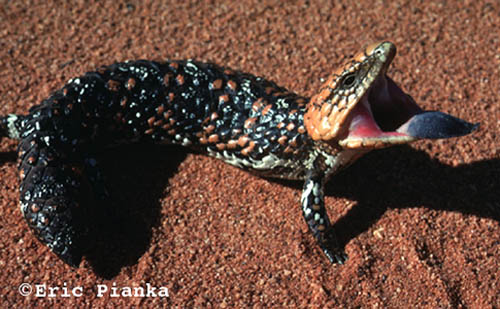


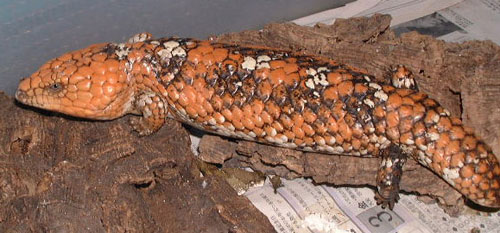

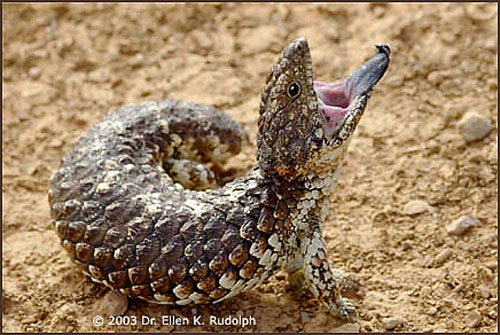
Below Photo Courtesy of Peter Robertson © Museum Victoria
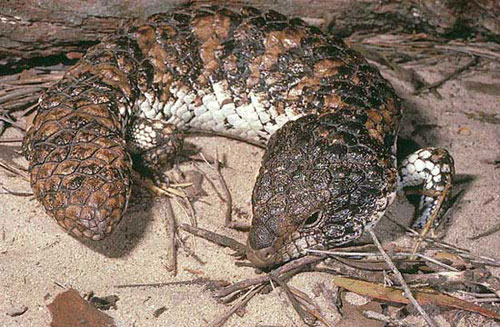
Click to enlarge
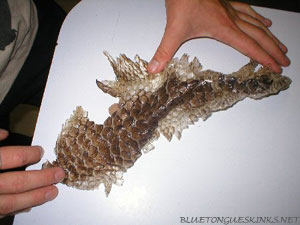
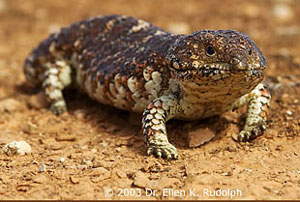




This looks like the 'Darth Vader' of the blue tongued skinks!
Shingleback babies


Click to enlarge

There are four Shingleback subspecies
- The Common Shingleback(T. rugosa rugosa • Gray, 1845)
• This species has a somewhat slender body, as well as a relatively long, thin tail. It is also the most colorful of the subspecies. Specimens seen with the bright orange/red coloration are the T. rugosa rugosa.
- The Eastern Shingleback (T. rugosa aspera • Gray, 1845)
• The largest in length, as well as body mass. The asperas have enormous armored scales that almost resemble a large pinecone (hence the nickname pinecone lizard). This species also has the broadest head, as well as a very wide, fat tail. Most species are solid black.
- The Sharkbay Shingleback (T. rugosa palarra • Shea, 2000)
• Long thin tails that in some cases, seem to end in a point. The validity of this scientific species is of some dispute. This animal's body structure (and other attributes) are nearly identical to the Common Shingleback.
- The (Rottnest) Island Shingleback (T. rugosa konowi • Mertens, 1958)
 ®
®
 ®
®